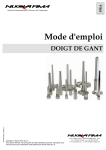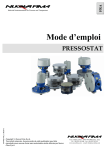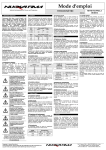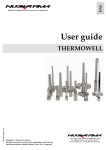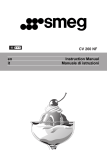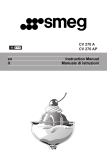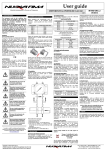Download User guide
Transcript
ENG Industrial instrumentation for Pressure and Temperature User guide MI-SEP-ENG_0 10/2011 DIAPHRAGM SEALS Copyright Nuova Fima S.p.A. All rights reserved. Any part of this publication should not be reproduced without a written Nuova Fima’s S.p.A. approval Via C. Battisti, 59/61 – 28045 INVORIO (No) – Italy Tel. +39 0322 253200 – Fax +39 0322 253232 www.nuovafima.com – e-mail: [email protected] User guide DIAPHRAGM SEALS Index 1. IMPORTANT INFORMATION________________________________________________________________3 1.1 INTENDED USE _____________________________________________________________________________3 2. INSTALLATION ____________________________________________________________________________4 2.1 THREADED PROCESS CONNECTION ______________________________________________________________4 2.2 FLANGED PROCESS CONNECTIONS OR WAFER ______________________________________________________4 2.3 FOOD PROCESS CONNECTION __________________________________________________________________4 2.4 IN LINE PROCESS CONNECTION _________________________________________________________________5 2.6 COMMISSIONING ___________________________________________________________________________5 3. WORKING LIMITS _________________________________________________________________________5 3.1 AMBIENT TEMPERATURE _____________________________________________________________________5 3.2 PROCESS MEDIUM CONNECTION ________________________________________________________________5 3.3 MATERIALS _______________________________________________________________________________5 3.4 WORKING PRESSURE ________________________________________________________________________5 3.5 OVERPRESSURE ____________________________________________________________________________6 3.6 RESPONSE TIME ____________________________________________________________________________6 4. WRONG USES ______________________________________________________________________________6 4.1 FAILURE FOR CORROSION _____________________________________________________________________6 4.2 FAILURE FOR EXPLOSION _____________________________________________________________________6 4.3 FAILURE FOR HIGH TEMPERATURE ______________________________________________________________6 4.4 MECHANICAL STRESS AND VIBRATIONS __________________________________________________________6 5. MAINTENANCE ____________________________________________________________________________6 5.1 REGULAR CHECK ___________________________________________________________________________6 5.2 PERIODICAL CHECK _________________________________________________________________________7 5.3 RECALIBRATION ___________________________________________________________________________7 6. DISMOUNTING AND DISPOSAL _____________________________________________________________7 2 NUOVA FIMA - Industrial instrumentation for Pressure and Temperature User guide DIAPHRAGM SEALS 1. Important information The instrument described in this manual has been designed and produced in conformity to the following standards in force. All components are submitted to severe quality and traceability controls. The quality management system is certified according to the ISO 9001 standard. This manual contains important information about the use and the installation of the gauge in safe conditions. Therefore it is highly recommended to read carefully the following instructions before using the instrument. The instrument works in safe conditions when correctly selected and installed in the system and when the rules concerning the product as well as the maintenance procedures established by the manufacturer are respected. The staff charged with the selection, installation and maintenance of the instrument must be able to recognize the conditions that may negatively affect the instrument's ability to work and which may lead to premature breakage. The staff must therefore be technically qualified and properly trained, and must carry out the procedures called for in the plant regulations. NUOVA FIMA instruments are designed and manufactured according to the safety rules included in the safety international standards in force. Some of these standards are included in this manual and they must be known and respected in order to proceed to the installation and the setting at work of the instrument. - - The manufacturer disclaims all responsibility in case of damages caused by the improper use of the product and by the non-respect of the instructions reported in this manual. Follow carefully the specific safety rules in case of measuring oxygen pressure, acetylene, inflammable or toxic gas or liquids. Disconnect the instruments only after depressurization of the system. The process fluids residuals in the disassembled instruments could affect people, the environment and the system. It is highly recommended to take proper precautions. Before installation be sure that the right instrument has been selected following the working conditions and in particular the range, the working temperature and the compatibility between the material used and the process fluid. This manual does not concern the instruments conforming to standard 94/9/CE (ATEX). The product warranty is no longer valid in case of non-authorized modifications and of wrong use of the product. The user is totally responsible for the instrument installation and maintenance. In order to verify the working and manufacturing features of the instruments read the catalogue sheets in the most up-dated edition available on.line on www.nuovafima.com 1.1 Intended use The diaphragm seal is designed to measure the process fluid pressure: when the process fluid temperature is noncompatible to the instrument sensing element, when the process fluid may corrode the inner parts of the measuring instrument in contact with the fluid, when the fluid is highly viscous or it contains solid suspensions, when it solidifies at temperature changes. NUOVA FIMA - Industrial instrumentation for Pressure and Temperature 3 User guide DIAPHRAGM SEALS 2. Installation A chemical compatibility check between the process medium and the wetted parts is requested before installation. A description about the instrument material is marked by laser on the upper and lower body of the instrument as well as on the seal label. Remove the diaphragm protection just before mounting treating it with extreme care. Scratches on the diaphragm are the main risk of chemical corrosion while crashing pressure on the concentric waviness affect the correct system operation. The capillary and in particular its welded joints must not be subject to torques or tractions. Do not carry the measuring system at the capillary. Capillary kinking and/or fracture can cause an inner bore throttling increasing the response time or they can cause the instrument failure totally compromising the instrument operation. Capillary cannot be bended under a radius of 150mm and it is recommended to fit it so that it is not subject to vibrations. The difference in height between the instrument and the diaphragm seal causes an hydrostatic effect on the measuring instrument and subsequently a variation in the instrument indication range. If known, this difference value must be indicated in the order otherwise the instrument must be reset on site. In order to dismount the instrument more easier for maintenance a shut off valve between the diaphragm seal and the system is recommended (root valve). 2.1 Threaded process connection In case of cylindric pressure connection thread the two plane faces are tighten up together by a ring seal. If the pressure connection thread is conic wrench for 5 complete threads at least and after having wrapped the male connection with PTFE before coupling. Warning – As gripping hold for the wrench use the seal side and not the gauge side, in order to prevent leaking of the filling liquid from the latter. In case of threaded connection with exposed membrane it is necessary to use the gasket which better complies with the chemical environment and the temperature at which the instrument is used. 2.2 Flanged process connections or wafer A proper seal should be selected considering its chemical and thermal compatibility as well as the flange tightness surface finishing type and degree. When mounting the seal between the diaphragm and the process connection take care to avoid any partial coverage of the diaphragm in order to prevent any leakage or damage to the diaphragm, in order not to partially hide accidentally the diaphragm 2.3 Food process connection It is recommended to select approved seals for food treatment. The quick connection components such as clamps, pulleys, flanges and nuts are not included in the supply and they are not described in this manual. Instruments with the DIN 11851 connection must be installed using special gaskets type SKS. Instruments with process connection conformed to ISO 2853 (IDS/ISS) must be installed using those gaskets with supporting ring as described in the above mentioned directive. 4 NUOVA FIMA - Industrial instrumentation for Pressure and Temperature User guide DIAPHRAGM SEALS 2.4 In line process connection In the first place install the welded stub, then fix the diaphragm seal inside the housing through the supplied studs. WARNING: the seal is generally metallic and the seal seat is created by pressure during the first installation. Proceed carefully to the studs clamping. 2.6 Commissioning In case of root valves they must be opened slowly. Verify that the connection is watertight and that the accessories are installed and fixed correctly. 3. Working limits 3.1 Ambient temperature The one recommended for the assembled instrument. 3.2 Process medium connection This instrument operates in safe conditions with a process medium temperature from -45 to +400°C depending on the filling liquid (see table), on the diaphragm material and on the process connection. For temperatures higher than the limits described in this manual please contact our Technical Assistance. Filling liquid Silicon oil type A Silicon oil type B Silicon oil type C Silicon oil type D Food liquid Fluoridated liquid Working temperature -45...+150°C (-49...+302°F) -20...+250°C (-4...+482°F) +20...+340°C (+68...+644°F) -5...+400°C (+23...+716°F) -20...+120°C (-4...+248°F) -60...+150°C (-76...+302°F) In case of high temperatures measuring the instrument can be equipped of a remote capillary or of a cooling turret. When a diaphragm seal provided with a cooling tower is installed on an insulated pipe, make sure that the insulating layer does not hide the tower’s radiant surface otherwise its features would be useless. Capillaries - Capillaries send the pressure values detected by the diaphragm at a distance. They are available in different lengths from 0,5 to 6m for the uncovered version or coated by a flexible stainless steel armour. Cooling tower - The cooling tower is used when instruments are directly installed or when process fluid temperature is higher than 100°C up to 250°C. 3.3 Materials - As for diaphragm seals coated with PTFE the process medium maximum temperature cannot be higher than, 150°C (302°F) - As for PVC diaphragm seals the maximum temperature must be 60 °C, at a maximum pressure of 1 bar. - As for food clamp diaphragm seals the maximum temperature can be 130°C for 1 hour during the cleaning and sterilization phases and 150°C if autoclavabile. - As for food diaphragm seals for homogenizers the maximum temperature can be 150°C for 1 hour during cleaning and sterilization. 3.4 Working pressure The instrument must be selected with a working pressure value between 25% and 75% of the full-scale range. The full scale range must be the double with respect to the working pressure. If the instrument is provided of a black small triangle placed on the dial full scale range the working pressure could be 90% in case of pulsating pressures and 100% for static pressures. NUOVA FIMA - Industrial instrumentation for Pressure and Temperature 5 User guide DIAPHRAGM SEALS Accuracy - At 20°C ± from 0,5 to 1% depending on the diaphragm seal type to be added to the accuracy class of the indication instrument. 3.5 Overpressure The overpressure value is the same as the one intended for the assembled instrument. Special overpressures are listed on the instrument dial or label. 3.6 Response time The diaphragm seal involves a response time which is proportional to the filling liquid viscosity and to the connection length between the diaphragm and the instrument. A capillary installation would increase the response time. 4. Wrong uses 4.1 Failure for corrosion When the diaphragm material is subject to a chemical attack form the chemical substances contained in the fluid to be measured a failure for corrosion could occur. In this case the material is weakened and a punctiform leak or a crack could take place. The diaphragm is thin so it works under mechanical stress. Therefore the chemical compatibility with the fluid to measure must be considered. None of the common materials can be immune from a chemical attack which depend on several elements such as: concentration, temperature and mix of different chemical substances. 4.2 Failure for explosion The silicon oil must not be used as a filling liquid with highly oxidants agents such as oxygen, chlorine, nitric acid and hydrogen peroxide because chemical inflammability or explosion spontaneous reactions could occur. In these cases the use of fluororube is recommended. 4.3 Failure for high temperature The filling liquid expansion due to temperature higher than the allowed one cause a diaphragm seal bulge which damages permanently the diaphragm and/or could cause the production of gas due to the filling liquid decomposition affects the assembling permanently making it unusable. 4.4 Mechanical stress and vibrations Instrument must not be affected by mechanical stress and vibrations. If the installation points are mechanically stressed instruments must be remote mounted and connected through a capillary. 5. Maintenance Mechanical instruments must be maintained following a proper maintenance program carried out and managed by skilled personnel. Diaphragm seals must be kept in good conditions in order to prevent any corrosion damage. All diaphragm seals are assembled and fixed to the instrument (except for DN63) through a seal label. If this label or the assembling are altered improperly the whole system working and the relevant guarantee are affected. ATTENTION: Do not remove or slack the filling valve and do not separate the instrument from the diaphragm seal. In case of leakage the assembling is not working anymore and must be returned in order to proceed to a separating circuit refilling. 5.1 Regular check The seal label must be placed on the instrument connection pivot. The connection between instrument and diaphragm seal must not leak as well as the upper and lower body and the filling valve. 6 NUOVA FIMA - Industrial instrumentation for Pressure and Temperature User guide DIAPHRAGM SEALS 5.2 Periodical check The corrosion level and the gaskets tightness condition must be checked every 3 to 6 months by disassembling the diaphragm seal from the system even if this is not scheduled in the maintenance program. Instruments must be isolated from the system by closing the root valve, pressure inside the instruments must be brought to zero through the drain devices and the temperature must be as much as close to the ambient temperature values. The remaining process fluid inside the instrument process connection must not be dispersed in the environment because it could be dangerous for people and the environment. In case of toxic fluid please handle with care. 5.3 Recalibration If after recalibration results are different from the nominal values declared on the catalogue sheet the recalibration procedure should be repeated. It is recommended to return the instrument to NUOVA FIMA for this procedure. NUOVA FIMA will not be responsible for any non authorized intervention on the instrument. Moreover the contract warranty and the CE Conformity Declaration will be no longer valid. 6. Dismounting and disposal In case of polluted, viscous or crystallizing process media it may be necessary to clean the diaphragm from time to time. Only remove deposits from the diaphragm with a soft brush and a suitable solvent. Do not use aggressive cleaning agents. Do not damage the diaphragm with sharp edged tools. Do not use powerful water jets for the diaphragm cleaning. Some models are prearranged for cleaning operations because they are flushed diaphragm seals or have an intermediate ring with a cleaning plug. Models with diaphragm welded to the upper body can be dismounted for cleaning. When remounted the gasket between upper and lower body must be replaced. Models with a mechanical tightness cannot be dismounted and must be disposed and returned to Nuova Fima for cleaning or maintenance. For disposal we recommend to separate the diaphragm seal from the instrument, empty the filling circuit, remove the window and the plugs then dispose it as aluminium and stainless steel. The remaining fluid inside the instrument could be toxic and dangerous. NUOVA FIMA - Industrial instrumentation for Pressure and Temperature 7







